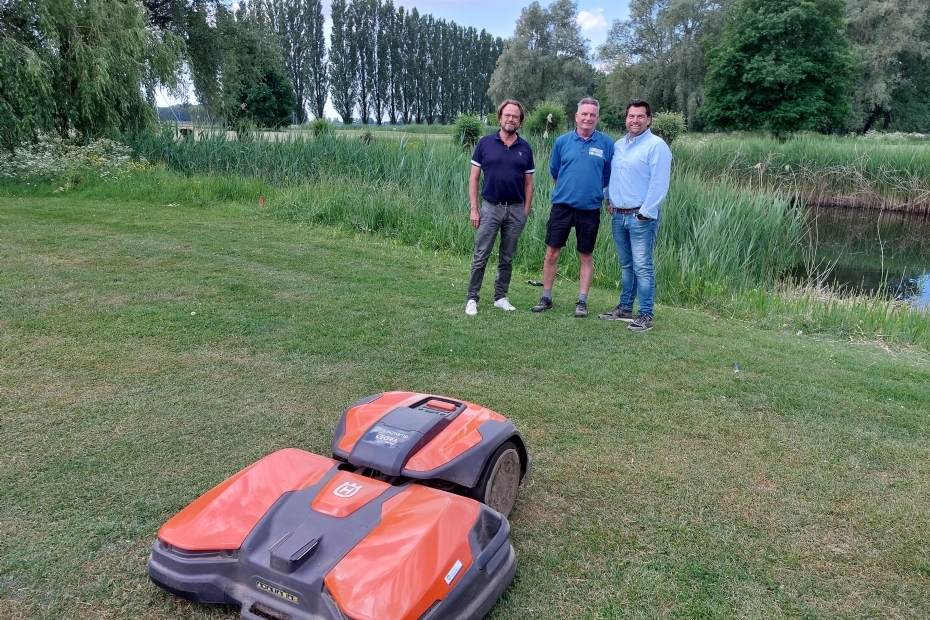Mowing robots at Golf Course Landgoed Welderen: 'Better quality, lower costs' Robots improve golf course while reducing operating expenses |
|
|
|
|
| Bart Mullinnk,
Tuesday 1 July 2025 |
 |
| 168 sec |
'You could buy two reel mowers for the price of nine robots'
Nine mowing robots now maintain the fairways, roughs and semi-roughs at Golfbaan Landgoed Welderen in Elst, Gelderland. Owner Dirk-Jan Vink is pleased: costs are going down, while returns are going up.
| A Ceora 546 at work on the semi-rough |
According to Vink, switching to robotic mowers makes strong financial sense. 'Nine Husqvarna Ceora 546 units cost around 260,000 euros in total. That's almost the same amount we'd spend on two reel mowers. And these robots replace four machines altogether: three reel mowers and a large seven-unit rotary mower. You do the math — that's a big win. You could buy a pretty nice car with the difference. Plus, they're more economical to operate. Over their full lifespan, the savings are even greater.' In short, Vink sees the move as sustainable in every respect. Fabian Storm of Husqvarna Netherlands listens with satisfaction to Vink's praise, though he adds a note of caution: 'In this case, the savings are clear, but it will differ per course. At another site, for instance, four Ceora units replaced a single intensively used fairway mower. In that case, the initial investment is roughly the same.'
|
|
'We can mow more frequently, which improves turf density'
| |
|
Usage and charging
Still, even in those cases, the overall costs remain favourable, Storm explains, particularly because of the lower running costs. 'The robots can run 24/7, which makes it easy to mow more frequently. That helps improve turf quality.'
Charging the battery is also much cheaper than filling diesel tanks, adds head greenkeeper Ronald van Os. One charging station had to be installed in a remote part of the 63-hectare course, where no power connection was available. That station will now get its own solar-powered supply. 'That means free electricity in the long run — though it does require an upfront investment.'
Maintenance
Maintenance is another area where savings occur. 'In the past, a mechanic came out every week to service all machines,' Van Os says. 'Now we handle the limited maintenance of the Ceora units ourselves, during the mowing season. That includes weekly cleaning, blade disk replacement every two weeks, and a monthly blade swap. Only in winter do we send them to the dealer for a full service.'
Labour and quality
Because the robots operate autonomously, labour costs are reduced as well. Their arrival coincided with the retirement of one team member. 'In theory, we could manage with one fewer person. But the time saved is now used to further improve course quality. That attracts players — and that, too, generates income.'
The nine Ceora 546 units each cover 5 hectares per 48-hour cycle, easily handling the 41 hectares to which they are assigned. According to the mowing schedule, each area is cut three times per week — a necessity, says Vink: 'The river clay here is extremely fertile. After a good rain, the grass grows so fast it's hard to keep up.'
Mowing height
The cutting height of the robots is adjustable between 10 and 60 millimetres. Cutting lower than that is problematic, which is one reason they're not used on the greens. According to Storm, no further development is expected in that area. 'Besides mowing height, the robots aren't suited for clippings collection.' Van Os and Vink don't mind, greens mowing is a relatively small part of the overall workload. Fairways, roughs and semi-roughs represent the majority of the surface area, and the robots handle those with ease.
While the three areas are mowed at slightly different heights, those heights must remain proportionate. That's why they're generally cut just as often.
|
|
'In the past, a mechanic visited weekly. With the robots, we handle most maintenance ourselves during the season'
| |
|
Signal coverage
One of the old machines has been kept for specific hard-to-reach spots where the robots can't operate due to weak signal from the central reference antenna. This is often caused by dense vegetation. Vink: 'That old mower is officially retired, but for a few hours a week, it still does the job.' That may soon be unnecessary. From next year, a solution will become available that enables Ceora robots to operate without a signal from a base station, Storm announces. 'This upgrade can also be added to existing units and could solve coverage issues in problematic areas.'
 | | V.l.n.r.) Dirk-Jan Vink, Ronald van Os and Fabian Storm on Golfbaan Landgoed Welderen in Elst |
|
|
Mowing pattern and turf quality
The first four robots were purchased last year for the fairways. The results were immediately noticeable, says Van Os. 'Turf density has improved thanks to more frequent mowing. And since only a small amount of grass is removed at a time, it acts as a natural fertiliser.' With the recent addition of five more Ceora units, the entire course now receives the same mowing treatment. 'The mowing pattern has become more consistent, too. In the past, mowing stopped on Friday afternoons. Players sometimes noticed longer grass on Sundays. That no longer happens.' The improvement in fairway quality hasn't gone unnoticed. 'Players give us nothing but positive feedback,' Van Os says. 'Which is great — although if I ever stop getting complaints entirely, I might start to miss them.'
| Golfbaan Landgoed Weldere... | |
| |
| LOG IN
with your email address to respond.
|
|
|
| There are no comments yet. |
|
| |
Anyone can place small ads for free through their own account.
Place a free ad
|
|
|
|